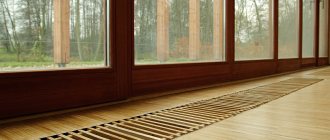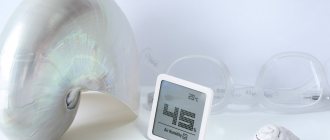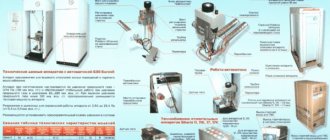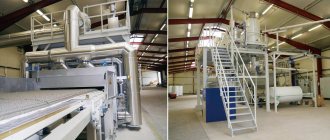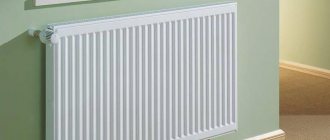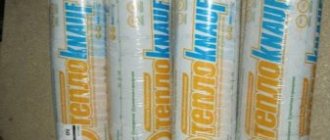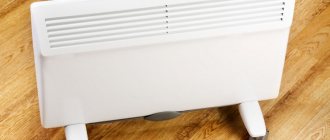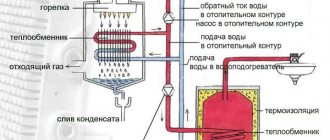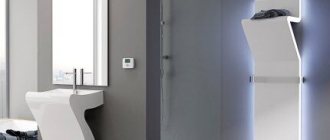The quality and efficiency of the heating system affects the creation of a comfortable environment in the living space. One of the main elements of the heating system is the radiator, which transfers heat from the heated coolant using radiation, convection and thermal conductivity.
They are divided into separate groups depending on the material of manufacture, design, shape, and application.
One of the important details that you need to pay attention to when choosing is the material of manufacture. The modern market offers several options: aluminum, cast iron, steel, bimetallic heating devices.
Aluminum radiators
Aluminum heat exchangers comprehensively heat the room by thermal radiation and convection, which occurs through the movement of heated air from the lower sections of the heater to the upper ones.
Main characteristics:
- Working pressure from 5 to 16 atmospheres;
- Thermal power of one section is 81–212 W;
- The maximum water heating temperature is 110 degrees;
- The pH of the water is 7–8;
- The service life is 10–15 years.
There are two manufacturing methods:
- Liteva.
At increased pressure, separate sections are made of aluminum with the addition of silicon (no more than 12%), which are joined into one heating device. The number of sections varies; additional ones can be attached to one section.
- Extrusion method.
This method is cheaper than casting and involves making the vertical parts of the battery using an extruder, and the collector from silumin (an alloy of aluminum and silicon). The parts are connected; adding or reducing sections is not possible.
Advantages:
- High thermal conductivity
- Light weight, easy installation
- Increased level of heat transfer, which is facilitated by the design features of the heat exchanger.
- Modern design that allows you to fit into any interior.
- Thanks to the reduced volume of coolant in the sections, aluminum units heat up quickly.
- The design of the battery allows the installation of thermostats and thermal valves, which contribute to economical heat consumption by regulating the heating of the coolant to the required temperature.
- Easy to install, installation is possible without the involvement of professionals.
- The outer coating of the battery prevents paint peeling.
- Low cost.
Flaws:
- Sensitive to shocks and other physical influences, as well as pressure surges. These batteries are contraindicated for installation in industrial enterprises due to high pressure in the heating system.
- The need to constantly maintain the pH level of water within acceptable values.
- Contaminated coolant - water with solid particles, chemical impurities - damages the internal protective layer of the walls, causing their destruction, corrosion and blockages, which reduces the service life. Filters need to be installed and cleaned.
- Aluminum reacts with oxygen in water, resulting in the release of hydrogen. This leads to gas formation in the heating system. To prevent rupture, an air release device must be installed, which requires constant maintenance.
- The joints between sections are prone to leakage.
- Aluminum radiators are not compatible with copper pipes , which are often used in modern heating systems. When they interact, oxidation processes occur.
- Weak convection.
How do the features and nuances of a central heating system affect the service life of radiators?
Central heating system
Before you start choosing a radiator for your apartment, you should take into account some of the nuances of the central heating system. Of course, central heating has more advantages than disadvantages. No need to bother with choosing and installing boilers or installing a chimney. The cost of utilities is easily controlled by installing a meter. But there are also disadvantages that affect the choice of batteries.
- The carrier always contains aggressive substances that negatively affect the material of pipes and batteries. Most often, it is corrosion that causes a destructive effect on the inner layer of radiators, reducing their service life. For preventive purposes, some utilities add lignosulfonate powder to water tanks, which does not have the best effect on the service life of radiators.
- The water that goes through heating pipes often contains fine sand, clay, and lime. Gradually, this small debris wipes the metal from the inside. If the inner layer is rough, this will shorten the service life much faster.
- One of the enemies of heating radiators in apartments is pressure drops, so-called water hammer. This, of course, negatively affects the condition of the batteries. Air jams created by the unstable operation of the central line gradually lead to cracking and rupture of the metal. But many modern radiators are equipped with safety valves that allow you to regulate the pressure in the pipes and thus combat pressure instability.
- The temperature instability of the heating system has the greatest impact on the internal part of the battery. Cast iron has the ability to expand when heated and contract when the temperature drops, which leads to cracking of the inner layer. Therefore, it is these batteries that are most vulnerable to temperature changes.
Therefore, when choosing a radiator for heating an apartment, be guided by these points and take into account the operation of the highway and local housing and communal services.
Steel radiators
Characteristics:
- Heat dissipation – 1200–1800 W;
- Working pressure indicator – from 6 to 15 atmospheres;
- The hot water temperature is 110–120 C.
- Steel thickness is from 1.15 to 1.25 mm.
Advantages:
- Low inertia. The steel heat exchanger heats up very quickly and begins to transfer heat to the room
- Increased heat transfer through thermal radiation and convection
- Long service life thanks to simple design
- Ease of installation
- A light weight
- Low cost
- Attractive appearance, original design. Steel are manufactured in various shapes, allowing them to be placed vertically, horizontally and at an angle
- Compatible with a variety of fastening materials
- High level of energy saving
- Installation of temperature controllers
- Simple design allows for easy maintenance
Flaws:
- Low corrosion resistance. Units made from the thickest steel can withstand a service life of no more than ten years.
- You cannot leave it inside for a long time without water, which is not suitable for central heating.
- Inability to withstand strong water hammer and pressure surges, especially in weld areas.
- If the outer coating was originally applied with flaws, it will begin to peel off over time.
Models of steel radiators differ in the type of connection - it can be side or bottom. The bottom connection is considered universal; it is discreet in the interior, but more expensive.
Depending on the number of panels and convectors, or internal sections, there are several types.
Type 10 has one panel without a convector, 11 has one panel and one convector, 21 has two heating panels and one internal section, and so on, by analogy, types 22, 33 and others are divided. Three-panel heat exchangers are quite heavy, heat up more slowly and require more complex maintenance.
Cast iron radiators
They are made of several identical sections cast from cast iron and hermetically connected to each other. When installing such a heater, it is necessary to decide on the number of sections, which depends on the area of the room, the number of windows, the height of the floor, and the corner placement of the apartment.
Characteristics:
- Withstand pressure 18 atmospheres;
- Hot water temperature – 150 C;
- Power 100–150 W;
Advantages:
- Resistant to corrosion. Cast iron is a wear-resistant material; the quality of the coolant does not affect functionality.
- Retains heat for a long time after heating stops.
- Service life 30 years or more.
- Compatible with other materials.
- Increased heat transfer due to the vertical arrangement of the internal fins.
- Heat resistance, strength.
- Due to the internal diameter and volume of the sections, minimal hydraulic resistance is created and blockages do not occur.
Flaws:
- Heavy weight, making it difficult to install and move.
- Slow heating.
- Impossibility of integrating a temperature controller.
- Difficult to care for and paint.
- The outer coating is not durable and may peel and flake. For this reason, it becomes necessary to periodically paint the battery.
- Unpresentable appearance.
- Increased fuel costs due to large internal volume.
- Cast iron heat exchangers have a porous inner surface that collects contaminants, which over time will lead to a deterioration in the thermal conductivity of the battery.
Types of screens for heating devices
In modern interior styles, the appearance of an accordion battery is not always suitable. For this reason, special casings are often used that fit over the device and provide the required design. You can use a sheet of steel to cover the facade of the device, but in most cases this is not enough. The best solution in terms of aesthetics and functionality is special screens for radiators. Such products completely cover the surface of the battery, but do not interfere with heat transfer. Air circulation is not disrupted and the device still effectively heats the room.
Screen designs are very diverse. The main ones include:
- Box It completely covers the radiator, but its surface is not flush with the wall. There are many ready-made solutions available on the market; each type of heating device has its own type of protective casing. The floor screen is simply attached to the wall, and the wall-mounted version is attached to a vertical surface with dowels. To regulate the temperature in the room, special devices with a remote sensor are used. Such equipment can be used for completely closed heating radiators.
Screen for the battery in the form of a box Source rusolymp.ru
- Screen. This product does not have end walls, which is the main difference from the previous version. The screen is located on top of the battery; it is quite light, since it is made of tin. Materials based on fabric, plastic and wood are also sometimes used. Such screens are combined with a radiator in cases of constructing a false wall. As a result of its construction, the device ends up in a niche, which is closed using a flat screen.
Screen for a radiator in the form of a screen Source peskiadmin.ru
Despite many advantages, screens also have certain disadvantages. They disrupt the circulation of heated air, which reduces the efficiency of the devices. The heat mainly heats the walls, since it stagnates in the area of the heat exchanger. In this case, it is better to insulate the wall with polystyrene foam, otherwise you will not heat the room, but part of the street.
Bimetallic radiators
This type includes devices with an aluminum body and steel pipes inside. They are most common when installed in residential areas.
Characteristics:
- Working pressure indicator – from 18 to 40 atmospheres;
- Thermal power – 125–180 W;
- The permissible coolant temperature is from 110 to 130 degrees;
- The warranty period is on average 20 years.
Varieties:
- 100% bimetallic, i.e. the inner core is made of steel, the outer part is made of aluminum. They are stronger.
- 50% bimetallic - only those pipes that reinforce vertical channels are made of steel. They are cheaper in cost than the first type and heat up faster.
Advantages:
- Long service life without the need for maintenance.
- Increased level of heat transfer. This is achieved due to the rapid heating of aluminum panels and the small internal volume of the steel core.
- Strength, reliability, resistance to mechanical stress and pressure surges.
- Resistance to corrosion due to the use of high-strength steel with a special coating.
- Light weight, easy installation.
- Aesthetic appearance that fits into the interior.
Flaws:
- Expensive.
- During the draining of water from the heating system, with simultaneous exposure to air and water, the steel core may be subject to corrosion. In this case, it is better to use bimetallic models with a copper core and aluminum panels.
- Aluminum and steel differ in their thermal expansion rates. Therefore, instability of heat transfer, characteristic noise and crackling inside the device are possible in the first years of operation.
For proper operation of a bimetal heat exchanger, it is recommended to install an air exhaust valve and shut-off valves on the inlet and outlet pipes.
Based on design features, they are divided into the following types:
- Sectional
- Panel
- Tubular
Sectional radiators
Devices consisting of sections of the same type connected together, inside each of which there are from two to four channels through which the coolant moves.
The housing with sections is assembled to the required thermal power, length, and shape. They are made from various materials - steel, aluminum, cast iron, bimetals.
Advantages:
- The ability to install additional sections or remove unnecessary ones depending on the required length of the heat exchanger and the area of the heated room.
- Increased heat transfer produced by radiation and convection.
- By increasing the number of sections, the power of the radiator increases.
- Low cost.
- Economical.
- Installation of temperature regulators.
- Various center distances allow the heater to be installed anywhere.
Flaws:
- The joints between sections are susceptible to water leaks, and with sharply increasing pressure they can separate.
- Difficulties in maintenance associated with removing contaminants in the space between sections.
- The inner surface of the sections has unevenness, which creates blockages.
Panel radiators
They consist of two metal panels treated with anti-corrosion protection, fastened together by welding. Inside the panels, coolant circulates through vertical channels, and ribs are attached to the back side to increase the area of the heated surface in a U shape.
Panel heat exchangers are divided into one-, two-, and three-row and are made of steel.
Advantages:
- The variety of sizes of panel boards allows you to select for heating in accordance with the area of the room. Depending on the dimensions, power increases or decreases. The large surface area of the shields has increased heat transfer.
- Due to its low inertia, the battery quickly responds to temperature changes.
- A light weight.
- Thanks to the compact design, the battery can be placed in hard-to-reach areas of the room.
- Low cost.
- To heat a panel radiator, several times less water is required than for a sectional one.
- Aesthetic appearance.
- Ease of installation due to integral design.
Flaws:
- Cannot be used in high pressure systems.
- They need clean coolant without chemical impurities and dirt.
- It is impossible to increase or decrease the dimensions for heating as is the case with sectional ones.
- If painting with a protective material is of poor quality, corrosion may occur.
- Sensitivity to water hammer.
How do accordion batteries work?
Modern radiators still resemble traditional Soviet batteries in their structure. They have changed in appearance, but have retained the same simple and reliable design that was used for older generation devices. The accordion battery received the following details:
- A curved pipe in the shape of the letter U, which has a pair of ball valves at the ends;
- Plates placed on a pipe. Often all parts are made of the same material, but there may also be combined devices.
- Protective cover. It is a kind of box with an open top and bottom. The internal size of the box allows you to place several pipes in it at once.
Tubular radiators
They consist of vertical tubes from 1 to 6, connected by a lower and upper manifold. Thanks to its simple design, unhindered and efficient coolant circulation is ensured.
The level of heat transfer depends on the thickness of the tubes and the dimensions of the unit itself, which vary from 30 cm to 3 m. The operating pressure withstandable by tubular models is up to 20 atmospheres. Made from steel.
The main advantage is resistance to pressure changes. The rounded edges and shape of the tubes do not allow dust and other contaminants to accumulate on their surface. The appearance is stylish and modern, the variety of shapes allows you to create a designer model for any interior. Strong welded joints prevent water leakage.
Disadvantages: susceptibility to corrosion and cost.
Thanks to convection, such radiators thoroughly warm the air in the room.
When creating comfortable living conditions, attention is paid to details that should harmoniously fit into the design of a residential or public space. Often, when implementing a design project, you need to organically fit every element into it.
The heating device also has a variety of shapes that can create the integrity of the interior. These include vertical, flat, mirror, floor, and baseboard devices made of various materials.
Vertical radiators
Units with vertical placement were created for those cases where indoor installation is not possible. This depends both on the interior design and on the dimensions or non-standard shape of the living space.
The vertical heat exchanger can be made part of the interior and not hidden behind decorative elements. The main difference is the dimensions, where the length exceeds the width, and vertical placement on the wall. A device of this type is indispensable in a room with panoramic windows.
Vertical radiators can be of various designs - panel, tubular, sectional, and made of various materials - cast iron, steel, aluminum. According to the method of connection to the heating system, there are side, bottom and diagonal.
Advantages:
- Large assortment of shapes and sizes, colors.
- Compactness, which is achieved by reducing the length of the battery along the wall.
- Decorativeness is also expressed in the invisibility of all its fastening and connecting elements.
- Ease of installation, which is achieved due to its low weight and integrity of its structure.
- Large area for increased heat transfer.
- Heating speed.
- Heating does not require a large amount of water, which helps save money.
- Easy to care for.
Flaws:
- Expensive
- The thermal performance of the heater may decrease due to the fact that the air above will always be warmer than the air below. Accordingly, the upper part will give off less heat than the lower part.
- Uneven distribution of heat over the entire area of the room due to the fact that radiated heat accumulates in the upper part of the room.
- It is recommended to install a battery with a reducer to normalize internal pressure.
In other cases, the disadvantages and advantages correspond to those that are characteristic of each type of conventional battery - sectional, tubular, panel.
Factors influencing work efficiency:
- One- or two-pipe connection in the system. The first is less economical in water consumption, but is easy to install and does not require unnecessary costs.
- Type of water supply to the system – top, bottom, side.
- Method of connection to the heating system. Diagonal connection is considered universal.
The effectiveness of heat transfer depends on the correct connection to the heating system. Before installation, it is important to insulate part of the wall to reduce heat loss.
Flat radiators
For compact placement and freeing up space, flat models are used.
Characteristics:
- Smooth front panel that does not allow dust to accumulate on it.
- Dimensions – from 30 cm to 3 m.
- A small amount of water is consumed, which makes it easy to regulate using thermostats.
- Bottom and side connection.
- Used as a decorative element, strict shapes or bright colors.
The operation is similar to panel and sectional: a coolant circulates between two metal sheets; if a heating element is installed, an electric flat version is obtained.
Working pressure is up to ten atmospheres, maximum water heating is 110 C. There are single-panel, double-panel and three-panel heaters.
The main advantage is its compact size and fast heating. In addition, they are easy to care for and have an attractive and stylish appearance. The decoration of flat heat exchangers allows them to fit into any room design, and the mirror surface will replace the mirror. Small installation depth and good thermal radiation indicator.
The disadvantages include the impossibility of installation in wet areas to avoid corrosion, as well as the high cost.
Flat and vertical should be equipped with air release devices, since this arrangement causes a difference in internal pressure.
Infrared heated floors.
Read in detail how to install it in this article. I recommend placing an additional layer of aluminum foil underneath it on a wooden base.
And be sure to always follow the rules for electrical installation on combustible substrates.
- Video 24. Installation and connection of heating.
- Connection and installation of heated floors.
- Installation of heated floors.
- How to calculate a heated floor
Floor radiators
A radiator identical to conventional wall-mounted heat exchangers, but installed on a horizontal surface. It consists of a heat exchanger with a coolant circulating in it, surrounded by plates of aluminum or steel and closed on the outside with a metal sheathing or protective casing.
Equipped with a valve to remove air and connect to pipes of any diameter. The only difference from the wall-mounted options is that the floor radiator is attached to the floor or stands independently on it.
Characteristics:
- Working pressure indicators up to 15 atmospheres;
- The heating temperature of the outer casing is up to 60 degrees;
- Coolant temperature – 110 C;
- Dimensions are up to 2 m in length and 1 m in height on average.
They are made of cast iron, aluminum, steel, bimetals. Many of the models can be transformed from wall-mounted to floor-mounted and vice versa using brackets.
Advantages:
- Fire-proof and injury-proof.
- Uniform heating of the room.
- A variety of shapes and sizes to suit the interior style and at the request of the buyer.
- The use of copper in the heat exchanger improves anti-corrosion qualities and increases service life.
- Built-in electronic and automated control.
- Economical.
- Installation is possible anywhere in the room where a hot water supply pipe is supplied.
- Providing natural convection.
- Built-in additional functions heat and purify the surrounding air.
- A floor-mounted heat exchanger is a convenient option in rooms where it is not possible to install wall-mounted ones due to weight, or where panoramic windows are installed.
- Compact sizes.
- Increased heat transfer.
- Resistance to mechanical stress.
Flaws:
- There may be problems with installation, since installing a floor radiator involves connecting pipes hidden under the floor.
- The cost with copper pipes and aluminum plates is quite high. Cast iron models are cheaper, but have lower thermal conductivity. Steel floor models have low heat transfer.
Bathroom radiators
A properly installed radiator will ensure a comfortable atmosphere in the bathroom, the absence of dampness, unpleasant odors, and maintaining an optimal level of humidity.
Divided by heating method and shape:
- Water heated by running water
They are connected to the heating system of the house using the conventional wall method. Additionally, it can be equipped with thermostats, with the help of which the required surface temperature is set.
It is recommended to use stainless steel, copper or brass as the outer covering of the water unit.
- Electrical
It functions autonomously and has a built-in heating element powered by mains power. Ease of installation. It is not able to heat the entire area of the bathroom, so it is advisable to use it in conjunction with other heaters, for example, with a heated floor system. In addition, this type is more expensive to maintain than a water type.
- Combined: water and electric.
Capable of operating from the heating system and from the network. The downside is the cost. There are simple forms and designer ones.
Depending on the material there are:
- Cast iron.
Pros: increased heat transfer, cheap price, good service life.
Cons: unattractive appearance. If there is no protective polymer layer, the outer paint coating will peel off and the battery will lose its appearance.
- Steel.
Disadvantages: susceptibility to corrosion, leaks that occur over time, which break through under strong water pressure.
- Aluminum.
Pros: light weight, compact size, attractive appearance.
Disadvantages: not suitable for systems with centralized heating, since they do not tolerate water hammer and coolant contaminated with sand and chemical impurities.
- Bimetallic.
Pros: service life (up to 20 years), good heat transfer performance, resistance to water hammer and pressure changes.
Cons: cost.
- Infrared.
Pros: convenient mounting anywhere in the bathroom, preserving the usable area of the room, ability to regulate temperature, heating objects in the room.
Cons: high cost.
The heating radiator in the bathroom, regardless of type and shape, can be covered with a decorative panel. This way the surface will not be exposed to external influences with a constant amount of emitted heat.
Types of heating devices
Accordion radiators are often classified according to the following criteria:
- The material from which pipes and plates are made;
- Number of “threads” in the casing;
- Connection diagram of the device to the coolant;
- Type of fastening of the casing to the support.
The first two types of device separation were described above. The third type of sorting of devices distinguishes the following varieties:
- With side connection. In this situation, the radiator fittings are located on the side of the casing. If the wiring in the room is installed horizontally, then the consumer will need to purchase special fittings. With their help, you can ensure the connection of the pipes of the device and the fittings to which it will be attached. In the case where the distribution pipes are located in a horizontal plane, angles are not used.
Side connection Source stroy-podskazka.ru
- With connection from below. In such products, the fittings are located on the bottom, which simplifies the connection with horizontal pipes, but complicates attachment to a vertically located system.
Connection from below Source fixmaster74.ru
The type of fastening to the supporting surface distinguishes the following devices:
- Mounted – mounted using special brackets;
Mounted radiator Source gipsokarton-blog.ru
- Built-in - their body is located below the floor level, installed directly on the floor slab.
Built-in radiator Source otoplenie-gid.ru
The first option has gained popularity due to its ease of installation and easy access to the structure. For floor products, you need to create a special niche and perform hidden wiring installation.
Radiator for apartment
In apartment buildings, not every unit can be used effectively for many years.
It is necessary to take into account the features of the central heating system:
- The coolant is contaminated in the form of various chemical impurities that can cause corrosion over time.
- Hard grains of sand and other blockages affect the pipe walls over time, causing them to wear out.
- The water temperature changes, as does the acidity level.
- Pressure surges cause divergence of the weld joints on the walls.
Selection options:
- The operating pressure in the unit specified by the manufacturer exceeds the pressure in the heating system.
- The heating device is resistant to water hammer.
- The inner surface of the heat exchanger walls must have a special protective coating that protects against the chemical effects of the elements on each other, and the thickness of the walls must withstand the physical effects of clogging particles from the inside.
- It is worth choosing the one with the greatest heat transfer.
- Duration of service life.
- Exterior design.
Options suitable for installation in an apartment:
- Bimetallic.
They meet all the necessary parameters for installation and long service in an apartment in a multi-storey building. They withstand water hammer, the maximum operating pressure is up to 50 atmospheres, internal and external treatment with a protective coating protects the surface from corrosion and wear.
Light weight makes installation easy, and the appearance is attractive in any interior. The only negative is that it is expensive.
- Cast iron.
The long service life, thick walls, resistance to corrosion, and chemically passive material of such heat exchangers create conditions for use in an apartment. Cast iron retains heat for a long time compared to other materials. Radiation heating is more effective than convection.
Good heat transfer, affordable price, when draining water from the system, the inner surface does not rust. Disadvantages - cast iron may not withstand too large pressure surges, it is heavy and creates inconvenience during installation.
Not suitable for installation in an apartment:
- Steel.
They cannot withstand the pressure typical of a central heating system, despite good heat transfer and economical use of resources.
- Aluminum.
Aluminum quickly corrodes when combined with water containing chemical impurities and its pH level, and cannot withstand high pressure in the heating system.
Bimetallic and cast iron are suitable. If the height of the house is more than five floors, and non-cast iron batteries were initially installed in the apartment, it is recommended to install bimetallic ones.
Conclusions and useful video on the topic
Useful tips from experts will help you understand the choice of heating device:
The best choice of heating radiator can be considered the one that achieves the greatest comfort and coziness. The radiator can be invisible or, on the contrary, be part of the overall design. But the most important thing is reliability and no hassle.
You can tell us about how you chose a radiator to replace old batteries in an apartment or to furnish a new home in the block below. Please write comments, ask questions, share useful tips and photos on the topic of the article. We are interested in your opinion.
